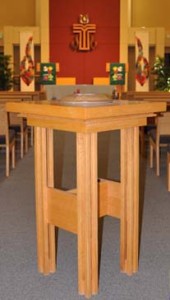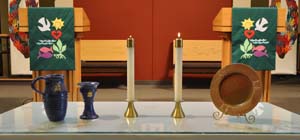
Worship
Lectionary
The worship lectionary during the Christian Education schedule (Labor Day through Memorial Day) follows the Revised Common Lectionary (RCL) with variations as deemed by our pastor to fit the season.
The RCL includes a reading from the Old Testament, a Psalm response to that reading, a Gospel, and an Epistle for each preaching occasion of the year. It is presented in a three-year cycle, with each year centered around one of the Synoptic Gospels. Year A is the year of Matthew, Year B is the year of Mark, and Year C is the year of Luke. John is read each year, especially during Advent, Lent, and Easter.
The RCL offers two tracks of Old Testament texts for the Season after Pentecost or Ordinary Time: a semi-continuous track, which moves through stories and characters in the Old Testament, and a complementary track, which ties the Old Testament texts to the theme of the Gospel texts for that day.
Presbyterian Sacraments
Denominations often differ over what they recognize as sacraments. Some recognize as many as seven sacraments, others have no sacraments in the life of the church. The Presbyterian Church (U.S.A.) has two sacraments, Baptism and the Lord’s Supper.
“The Reformed tradition understands Baptism and the Lord’s Supper to be Sacraments, instituted by God and commended by Christ. Sacraments are signs of the real presence and power of Christ in the Church, symbols of God’s action. Through the Sacraments, God seals believers in redemption, renews their identity as the people of God, and marks them for service” (Book of Order, W-1.3033.2).
Baptism

“In Baptism, the Holy Spirit binds the Church in covenant to its Creator and Lord. The water of Baptism symbolizes the waters of creation, of the flood, and of the Exodus from Egypt. Thus, the water of Baptism links us to the goodness of God’s creation and to the grace of God’s covenants with Noah and Israel. Prophets of Israel, amidst the failure of their own generation to honor God’s covenant, called for justice to roll down like waters and righteousness like an everflowing stream. (Amos 5:24) They envisioned a fresh expression of God’s grace and of creation’s goodness — a new covenant accompanied by the sprinkling of cleansing water. In his ministry, Jesus offered the gift of living water. So, Baptism is the sign and seal of God’s grace and covenant in Christ” (Book of Order, W-2.3003).
“Baptism enacts and seals what the Word proclaims: God’s redeeming grace offered to all people. Baptism is God’s gift of grace and also God’s summons to respond to that grace. Baptism calls to repentance, to faithfulness, and to discipleship. Baptism gives the church its identity and commissions the church for ministry to the world” (Book of Order, W-2.3006).
“The water used for Baptism should be common to the location, and shall be applied to the person by pouring, sprinkling, or immersion. By whatever mode, the water should be applied visibly and generously” (Book of Order, W-3.3605).
“Baptism is received only once. There are many times in worship, however, when believers acknowledge the grace of God continually at work. As they participate in the celebration of another’s Baptism, as they experience the sustaining nurture of the Lord’s Supper, and as they reaffirm the commitments made at Baptism, they confess their ongoing need of God’s grace and pledge anew their obedience to God’s covenant in Christ” (Book of Order, W-2.3009).
“As there is one body, there is one Baptism (Ephesians 4:4-6). The Presbyterian Church (U.S.A.) recognizes all Baptisms with water in the name of the Father, of the Son, and of the Holy Spirit administered by other Christian churches” (Book of Order, W-2.3010).
Lord’s Supper

“The Lord’s Supper is the sign and seal of eating and drinking in communion with the crucified and risen Lord. During his earthly ministry Jesus shared meals with his followers as a sign of community and acceptance and as an occasion for his own ministry” (Book of Order, W-2.4001a).
“Around the Table of the Lord, God’s people are in communion with Christ and with all who belong to Christ. Reconciliation with Christ compels reconciliation with one another. All the baptized faithful are to be welcomed to the Table, and none shall be excluded because of race, sex, age, economic status, social class, handicapping condition, difference of culture or language, or any barrier created by human injustice. Coming to the Lord’s Table the faithful are actively to seek reconciliation in every instance of conflict or division between them and their neighbors” (Book of Order, W-2.4006).
“The Lord’s Supper is to be observed on the Lord’s Day, in the regular place of worship, and in a manner suitable to the particular occasion and local congregation. It is appropriate to celebrate the Lord’s Supper as often as each Lord’s Day. It is to be celebrated regularly and frequently enough to be recognized as integral to the Service for the Lord’s Day” (Book of Order, W-2.4009).
“The invitation to the Lord’s Supper is extended to all who have been baptized, remembering that access to the Table is not a right conferred upon the worthy, but a privilege given to the undeserving who come in faith, repentance, and love. In preparing to receive Christ in this Sacrament, the believer is to confess sin and brokenness, to seek reconciliation with God and neighbor, and to trust in Jesus Christ for cleansing and renewal. Even one who doubts or whose trust is wavering may come to the Table in order to be assured of God’s love and grace in Christ Jesus” (Book of Order, W-2.4011a).
